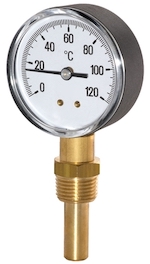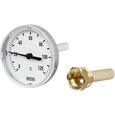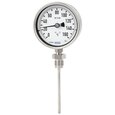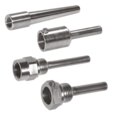Bimetallic Thermometer Calibration

Figure 1: A bimetallic thermometer
Bimetallic thermometers lose calibration for various reasons, so regular calibration of bimetallic thermometers is essential as a part of their regular operation. If the thermometer is not calibrated, the resulting temperature reading will be inaccurate. Inaccurate measurements can lead to product defects, poor quality control, and safety hazards. This article covers the most accurate method for calibrating a bimetallic thermometer and why it can become uncalibrated.
View our bimetallic thermometer selection here!
What is a bimetallic thermometer
To learn more about how these thermometers work and their application, read our bimetallic thermometer overview and bimetallic thermometer applications articles.
A bimetallic thermometer has a fused stem composed of two different metals. The two most common metals used are steel and copper. The important point is that the two metals have different thermal expansion properties. They react to temperature changes differently, and the stem bends since they are fused together. The thermometer has a mechanical or, in the case of digital thermometers, a digital mechanism that monitors the stem's bending. This translates to a temperature reading on the thermometer's face.
How to calibrate a bimetallic stemmed thermometer
This section describes two methods for calibrating a bimetallic thermometer that operates at a variety of temperature ranges: the ice point and boiling water methods. Both methods are suitable, but the ice point method is safer and more accurate for calibrating a bimetallic thermometer. Also, if a calibrated reference thermometer is not available, the ice point method is the most dependable since the slurry is known to be at 0 °C. Changes in atmospheric pressure and elevation can impact the boiling water method. Follow the steps below to calibrate a bimetallic thermometer.
Note: If the thermometer does not have a calibration screw or calibration nut, send it to the manufacturer for calibration.
Ice point method
- Create an ice slurry or ice water in a cup using crushed ice and a small amount of water.
- Put the thermometer probe into the slurry. Ensure the sensor contacts the ice.
- Wait for the temperature reading to stabilize (i.e., the pointer stops moving). This may take several minutes.
- Use the calibration screw to adjust the reading until it reads 0 °C (32 °F).
- Check the calibration by taking temperature readings at various temperatures. If possible, have a calibrated reference thermometer on hand to verify results.
Boiling water method
- Fill a cup with boiling water and put the probe in the cup.
- Wait for the temperature reading to stabilize.
- Use the calibration screw to adjust the reading until it reads 100 °C (212 °F).
- Check the calibration by taking temperature readings at various temperatures. If possible, have a calibrated reference thermometer on hand to verify results.
Single temperature range
For bimetallic thermometers that always operate in a single temperature range, it's best to calibrate the thermometers within this range rather than using the ice point or boiling water methods. The following steps describe how to calibrate a thermometer that always measures between 50 and 60 °C:
- Calibrate the reference thermometer using the ice point method.
- Heat water to a temperature between 50 and 60 °C.
- Use the bimetallic and reference thermometers simultaneously to take temperature readings of the water.
- Adjust the bimetallic stemmed thermometer's calibration nut or screw to match its temperature to the reference thermometer's reading.
When should a bimetallic stemmed thermometer be calibrated?
There are several reasons why the results of a bimetallic thermometer may be inaccurate. The thermometer needs to be calibrated in any of the following situations:
- New thermometer: Calibrate a bimetallic thermometer if it's right out of the box unless there is a calibration certificate with the thermometer.
- Long storage: If the thermometer has been sitting in storage for a long time, it may be less sensitive to changes in temperature.
- Different temperature range: Using a thermometer in a specific temperature range for an extended period will make it less sensitive to temperatures outside that range.
- Dropped thermometer: Dropping a thermometer may slightly move the calibration nut, making its readings inaccurate.
- Inaccurate reading: If the temperature reading does not seem accurate, take a reading with a calibrated thermometer as a reference. If the reading of the first thermometer is not within ±0.5 °C (±1.0 °F) of the reference thermometer's reading, it needs calibration.
- Extreme temperatures: The bimetal strip can bend when exposed to extreme temperatures. This misaligns the pointer, which results in inaccurate readings.
- Environmental factors: Humidity, pressure, and vibration can negatively impact the bimetallic thermometer's accuracy.
FAQ
How often should you calibrate a bimetallic thermometer?
The frequency of thermometer calibration depends on its application. For example, in extreme temperature and food safety applications, calibrate the thermometer each day. Check the manufacturer's guidelines for more instructions.









